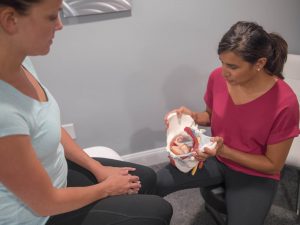
Women who experience a Cesarean section delivery with their first childbirth may be fearful of attempting a vaginal delivery in the future. However, 90% of women who have undergone a C-section delivery are candidates for a vaginal birth after Cesarean section (VBAC). For this reason, it is important for caregivers to emphasize that subsequent children can be delivered vaginally. Counseling and proper education can help reduce the ever-increasing number of women who request a repeat Cesarean section due to a fear of vaginal delivery.
Cesarean sections should only be performed when it’s safer than vaginal delivery for the mother or the baby because the rates of morbidity and mortality are several times higher in C-sections. Women are three times more likely to die during a Cesarean delivery than a vaginal birth due to factors such as blood clots, infections, and complications from anesthesia. Overall, a VBAC is associated with fewer complications than an elective repeat C-section
Your health care provider can help you determine if you are a candidate for a VBAC. Providers will not offer you the VBAC option for several reasons:
In a vaginal birth, your baby will receive beneficial bacteria that bolsters their gut health and boosts their immune system. Additionally, as the baby progresses through the birth canal, fluid will be squeezed out of your baby’s lungs. The inability of the newborn’s lungs to expel or absorb amniotic fluid during and following delivery can cause a condition known as transient tachypnea of the newborn (TTN), which causes labored breathing in newborns. Babies born by Cesarean delivery are more likely to develop TTN than babies born through a vaginal birth.
Furthermore, vaginal births after a C-Section delivery have the following benefits:
If you choose to attempt a VBAC when you go into labor, you’ll follow a process similar to that used for any vaginal delivery. Your health care provider will continuously monitor your baby’s heart rate and should be prepared to perform a repeat C-section if needed.

With a vaginal birth, you might think, “What about the risk of damaging my pelvic floor?”
Vaginal injuries are common during childbirth. 80% of women need stitches after a vaginal delivery (however, a small tear rarely causes long-term health problems) and between 13-30% of vaginal births result in injury to the deep muscles of the pelvic floor. Potential causes of injury to the vagina and pelvic floor muscles include a large baby head circumference and instrumental damage, especially from forceps used to aid vaginal delivery. If injury to the pelvic floor muscles occurs with birth, you should seek treatment from a pelvic floor physical therapist like those at Rebalance Physical Therapy.
Physical therapy treatments postpartum typically incorporate internal and external massage to the pelvic floor. Pelvic floor massage increases blood flow to the area to promote healing and helps desensitize the area to reduce pain. Other treatments involve exercises to restore normal muscle recruitment and coordination along with relaxation techniques to release tight and tense muscles. If you do not have a pelvic floor physical therapist near you, Rebalance Physical Therapy can help with the at-home C-Section Solution course. In the video course, you’ll learn how to recover from your C-Section delivery through easy-to-follow education and instruction led by pelvic floor physical therapists with over 20 years of experience. If you’ve had a C-section before and didn’t get the right rehab, our online program can help improve your core and scar tissue to prepare you for a safe and healthy VBAC.
In-Person and Online Consultations


